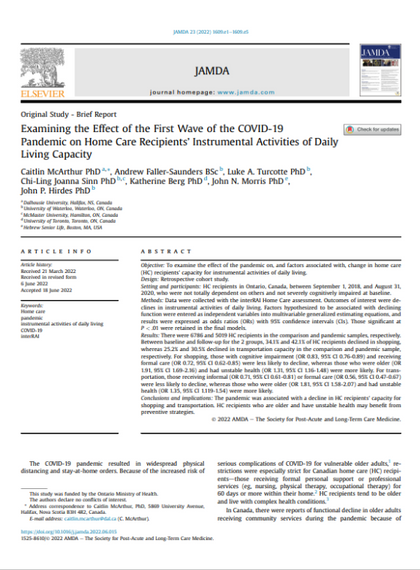Examining the Effect of the First Wave of the COVID-19 Pandemic on Home Care Recipients’ Instrumental Activities of Daily Living Capacity
Examines the effect of the pandemic on, and factors associated with, change in home care (HC) recipients’ capacity for instrumental activities of daily living. A retrospective cohort study.
Author: Caitlin McArthur PhD, Andrew Faller-Saunders BSc, Luke A. Turcotte PhD, Chi-Ling Joanna Sinn PhD, Katherine Berg PhD, John N. Morris PhD,
John P. Hirdes PhD
Publication Date: June 18, 2022
Description:
Objective: To examine the effect of the pandemic on, and factors associated with, change in home care (HC) recipients’ capacity for instrumental activities of daily living. Design: Retrospective cohort study. Setting and participants: HC recipients in Ontario, Canada, between September 1, 2018, and August 31, 2020, who were not totally dependent on others and not severely cognitively impaired at baseline.
Methods: Data were collected with the interRAI Home Care assessment. Outcomes of interest were declines in instrumental activities of daily living. Factors hypothesized to be associated with declining function were entered as independent variables into multivariable generalized estimating equations, and results were expressed as odds ratios (ORs) with 95% confidence intervals (CIs). Those significant at P < .01 were retained in the final models.
Results: There were 6786 and 5019 HC recipients in the comparison and pandemic samples, respectively. Between baseline and follow-up for the 2 groups, 34.1% and 42.1% of HC recipients declined in shopping, whereas 25.2% and 30.5% declined in transportation capacity in the comparison and pandemic sample, respectively. For shopping, those with cognitive impairment (OR 0.83, 95% CI 0.76-0.89) and receiving formal care (OR 0.72, 95% CI 0.62-0.85) were less likely to decline, whereas those who were older (OR 1.91, 95% CI 1.69-2.16) and had unstable health (OR 1.31, 95% CI 1.16-1.48) were more likely. For transportation, those receiving informal (OR 0.71, 95% CI 0.61-0.81) or formal care (OR 0.56, 95% CI 0.47-0.67) were less likely to decline, whereas those who were older (OR 1.81, 95% CI 1.58-2.07) and had unstable health (OR 1.35, 95% CI 1.119-1.54) were more likely.
Conclusions and implications: The pandemic was associated with a decline in HC recipients’ capacity for shopping and transportation. HC recipients who are older and have unstable health may benefit from preventive strategies.
Access: Free
Keywords: Home care, pandemic, instrumental activities of daily living, COVID-19, interRA



